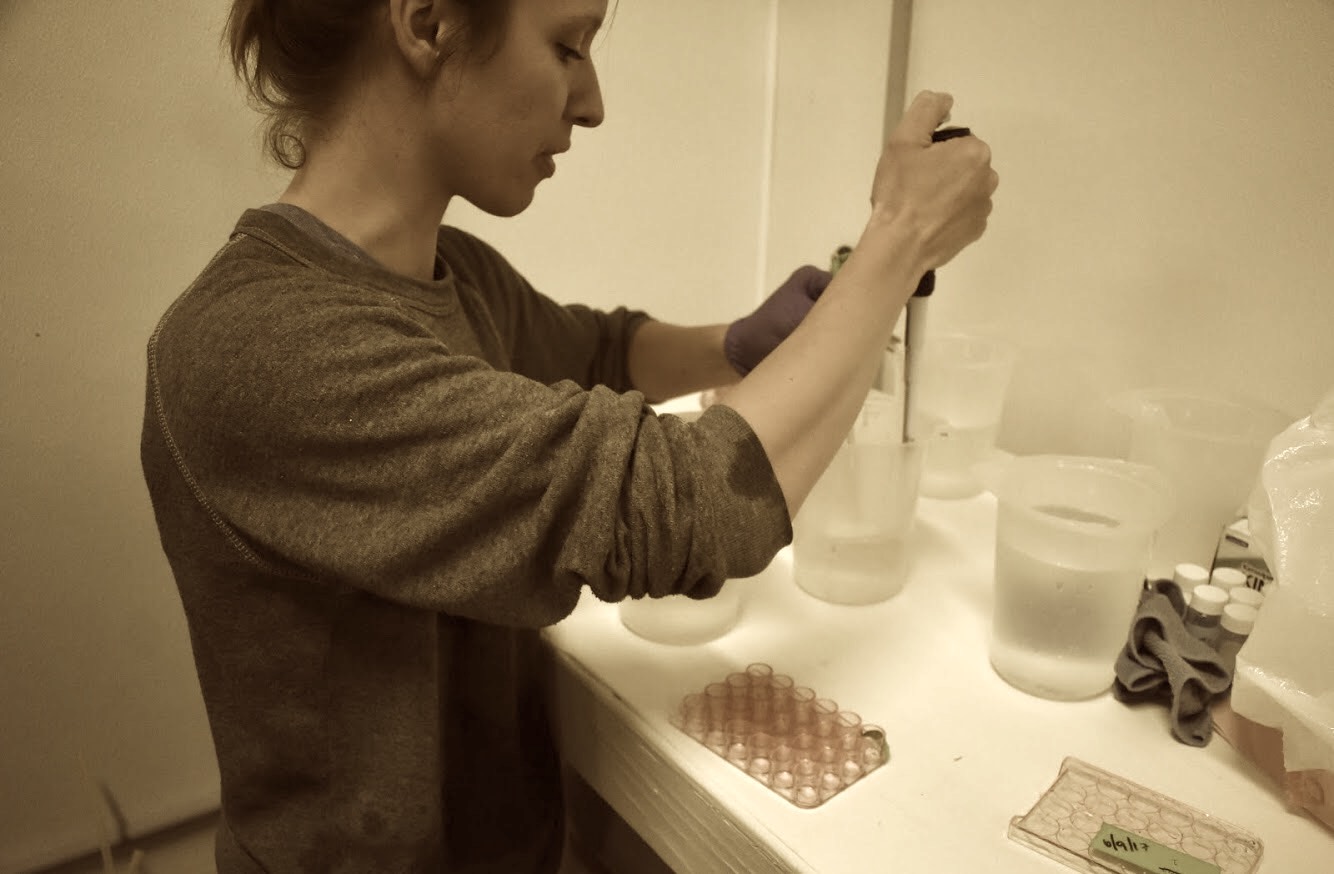Tank Swap! (etc.)
It’s been 2 week’s since the OA experiment started, so today was an intensive cleaning and re-organizing day. But first, Yaamini and I spent the morning at the monthly hatchery meeting, and learning about how Olympia oysters swim around in OA from Western Washigton crew (Shawn Arellano and her students). Then…
Chemistry Sampling:
Took 4oz bottle samples and injected with 50ul HgCl each, and measured T, mV (pH), and Salinity of grab samples taken at the same time. Note: Duplicate bottle samples are taken in each tank, in different locations within the tank; A=front-bottom, B=back/top.
Temp Loggers:
A new set of HOBO pendant data loggers had soaked overnight in the same water; we downloaded the data from this “cross-calibration,” then programmed them start collecting data at the same time (sychronized), and had them ready to be swapped into the culture tanks.
Swapped Header Tanks:
We have 2 header tanks that our water cycles through before being pumped to the culture tanks, one for each treatment. One header tank is injected with CO2, and one isn’t. Just in case there are differences between tanks (e.g. microbes, chemicals, etc.), we are swapping tanks a few times throughout the experiment. Today’s the day! It worked surprisingly well:
- At ~12pm, drained Header 1, which had been the low pH tank since starting the experiment. Started refilling Header 1 with un-treated water.
-
Disconnected the CO2 line to Header 1 and capped it, and connected it for Header 2.
- Closed valve leading to culture tanks (needed to clean them anyway!)
- Started injecting Header 2 with CO2 using the same settings:
- pH overshot a bit, which likey was due to the fact that water wasn’t being pumped out to culture tanks during cleaning, so CO2 built up. To stabilze pH at ~7.2, we opened two lines full-blast, which did the trick in ~45 minutes.
This is what the inside of a drained header tank looks like:
Cleaned Oysters and Culture Tanks
Every other week we siphon the poop out of the tanks and spray the Olympia oysters with fresh water, and opposite weeks we fully drain & clean the tanks. Today’s a cleaning day! We cleaned one tank at a time, in this order: 6, 5, 4, 1, 2, 3:
- Removed Oly’s, left on the screening table for a few minutes
- Used large siphon to drain tank
- Removed Pacifics, put onto an oyster tray with it’s labeled HOBO logger to not lose track of who is who
- Pulled tank down and cleaned with Vortex cleaning solution (~1ml/L), rinsed with fresh water
- Sprayed all oysters thoroughly with fresh water and inspeced for mortality
- Yaamini’s Pacific oysters were harboring critters, so she spent the afternoon cleaning them well.
- Note: I’ve occassionally found an annelid in an Oly bag, which I remove.
- Refill culture tank, and replace oysters.
Cleaning in progress:
Refilled & reorganized
- After refilling tanks, we relocated the oysters along their respective manifolds, and moved their “tank #” label. So, on the low pH side, the order of animals went from 1, 2, 3 -> 3, 1, 2. HOBO loggers followed their respective tank #’s. The purpose of this was to eliminate the effect of line/manifold position.
- Since we swapped header tanks, we also swapped the tubes going into the culture tanks - for example, culture tank #1 originally received water from the west manifold; after swapping header tanks, culture tank #1 remained on the same side of the table but received water from the east manifold.
- We fed each tank of oysters 1L of algae diet (pulled from algae header), since they had been without food for a few hours during cleaning.
- We removed the HOBO loggers that had been collecting data for the past 2 weeks, and replaced them with the newly programmed loggers.
- We also moved pH probes around; we forgot to document where they went, but Yaamini will do so on Monday.
Cleaned filters
We replaced all filters (1um, 5um, 20um). The 1um needs to be replaced every Wednesday, and sprayed out on Mondays. The 5 and 20 are also sprayed on Mondays, replaced on Wednesdays, but we use them again after letting them dry for 1 week.
Considered Algae
I’m concerned that there isn’t enough algae in the tanks to keep my Oly’s fat and happy, particuarly because Yaamini’s oysters are so massive and the flow is pretty high (~1.25 L/min, or ~16.5 gal/hr). Here’s a look at grab samples taken from the culture tanks prior to draining them:
PSRF has been using 300mL of Reed’s Shellfish Diet per 24 hrs (this is split between the experiment, and the other pacific oysters we’re holding on to), which drains in about 18 hours. After chatting with Ryan, we’ve asked them to begin increasing the daily feeding to 500mL.
